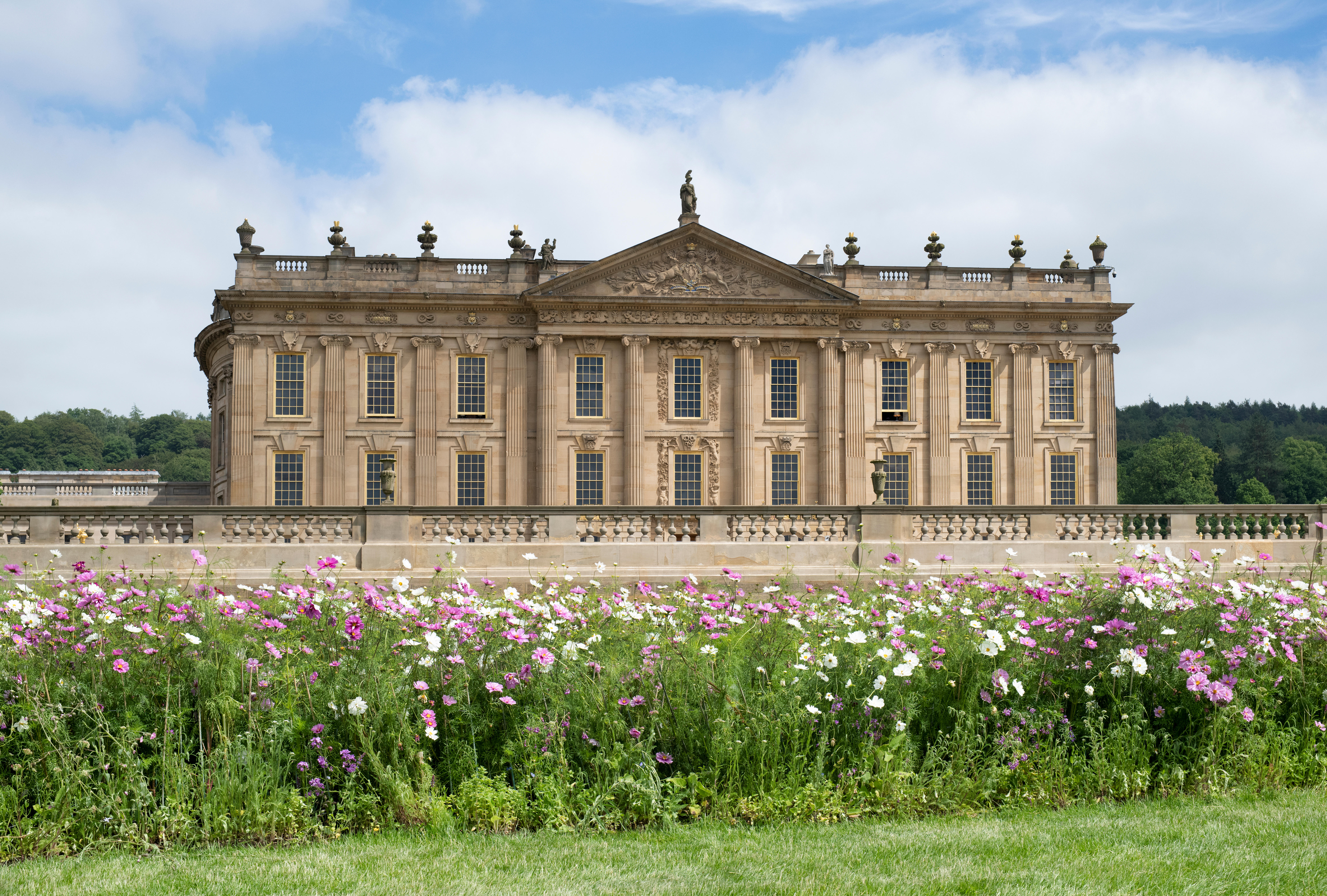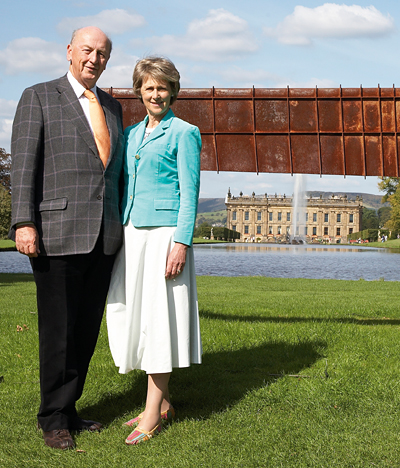Interview: Duke of Devonshire
Clive Aslet finds out what’s new at the Duke of Devonshire’s seat Chatsworth for this year as the house prepares to re-open


We are standing in the courtyard at Chatsworth, and the 12th Duke of Devonshire is looking for something. Hidden among the martial trophies his ancestor had carved between the windows in the 1690s is a modern introduction, added when the carvings were restored as part of the grand redisplay of Chatsworth that has recently come to fruition. It's a tank. Only he can't find it: not even a Duke of Devonshire can know everything about this, the greatest of English Treasure Houses, particularly when it's changing all the time.
Beside the trophies, the windows, including glazing bars, have just been re-gilded. To the delight of all, traces of 17th-century gilding have been discovered on the tops of the flaming urns on the skyline, so more gold leaf has been applied to those, too. The 1st Duke rebuilt the house ‘to make a really swanky, show-off place' he did not spare the bling. Showman-ship remains a Cavendish gene. As the present Duke says, living at Chatsworth ‘is the best fun'.
It was six years ago that Stoker, if we may be permitted the familiarity of a prep-school nickname, inherited the dukedom. A man then just short of 60, already housed in comfort at Bolton Abbey, might have been expected to think twice about relocating to a palace visited by 290,000 people a year (650,000 if you include those coming to the grounds and farmyard). But, ‘it's not just the house, but the whole enterprise. To ignore that would have meant going to live somewhere else. This has always been my home, it would have been odd'.
An urbane figure, the Duke doesn't wear his emotions on his well-tailored sleeve. But he almost bubbles when describing the ‘endless things to be done'. Chatsworth is his toy box. ‘There are lots of projects, which is great. Absolutely fascinating.' The best thing about it? ‘Looking out of the window is not a bad start,' he smiles. The fact that nearly all the people who come ‘seem to like it very much' creates ‘a very nice atmosphere'. Visitor satisfaction is put down to staff: ‘We just float about. I can't imagine not being completely besotted by Chatsworth.'

Things might have turned out very differently had not the Duke's parents been equally committed. Facing 80% death duties in 1950, Stoker's parents made the brave, almost insane, decision to make a go of the house. They turned it into ‘a mini National Trust' in 1981. ‘We have been able to reap the benefit of long years of hard work', the result of which has been a £15 million campaign of improvements. Despite the gilding, the impulse behind it wasn't glamorous: after 60 years, services needed to be replaced. To install new water and heating systems, telephone apparatus and security arrangements meant ‘digging up most of the house'. That gave the opportunity to improve access.
Because the 1st Duke had created his palace around the core, the Elizabethan house that he had inherited, the state rooms are not on the piano nobile, as with other Whig palaces, but on the top floor. Until now, this has presented disabled visitors with the challenge of several staircases.
Ingeniously, architect Peter Inskip has devised three new galleries around the courtyard; windows blocked up by the 6th Duke to create a space to show drawings have been exposed. The courtyard has been opened up to the public (perhaps somebody will find the tank). But that's not all.
Exquisite houses, the beauty of Nature, and how to get the most from your life, straight to your inbox.
The galleries constitute a completely new addition to the house, giving the opportunity to display works associated with Lord Burlington, champion of Palladianism and the early 18th century's arbiter of taste, and the famously beautiful Georgiana, wife of the 5th Duke. ‘Burlington's influence on the collection was enormous, but has never been explicitly explained because he was from a different family.'
It was through Burlington's daughter, who married the 4th Duke, that the Devonshires acquired Chiswick House, Burlington House, Lismore Castle and Bolton Abbey ‘a good lot of real estate', as the Duke puts it. Georgiana and the 5th Duke lived in what are now the family apartments: the great 18th-century portraits, including the Maria Cosway of the duchess flying through clouds, have there-fore been impossible to show in context. The third gallery will show contemporary works, the Duke's abiding long-term interest, on rotation: a major new commission for a ceramic fireplace is being awarded.
The Royal Apartments, built for a visit of William III that never happened, have been put back to the 1st Duke's time. ‘They had become a bit of an accumulation. Generations put things down and they were never moved. The layering effect is a very interesting thing about the British country house, which is important to have-but not everywhere.' Thus, the Great Chamber has been all but emptied of furniture to show it as the waiting room that it effectively was.
The fireplaces will be crammed with blue-and-white porcelain, which scholars now realise was how they would have been displayed in the 17th century, when fires weren't lit. Visitors will be able to feel the spaces becoming more crowded as they approach the royal bedchamber, fragrant with incense because the silver perfume burners are being brought back into use.
‘The balance between the didactic approach and displaying Chatsworth as a private house is,' observes the Duke, ‘quite difficult to get right. We might have swung a bit too far to the didactic, but nothing stays the same forever'. Besides, this generation of Devonshires are collectors: won't they be integrating the contemporary with the old? ‘Integrate?' queries the Duke, with the raise of an eyebrow. ‘We'll put them in the same rooms.' Already you can encounter Allan Jones's Carefree Man on the ground floor of the Painted Stair, and a huge tower of blue-and-white ceramic by Felicity Aylieff on the Great Stairs landing.
Each spring and autumn, Sotheby's, of which the Duke is deputy chairman, arrives with 20 spectacular modern works, such as Mark Quinn's huge, apparently floating, baby, Planet. Contemporary pieces are, says the Duke, easier to place in the garden than in the house. But they have to be ‘people proof'. ‘We would not commission a new piece of sculpture for the garden without explaining to the artist that it's got to be climbed on.'
However, the garden does raise a ‘moral issue': should the old stone statues be covered up during the winter? ‘I know that it is not very good for them not to be covered up, but I also know that it would look very, very depressing to have them swathed in whatever.' Because of the public? ‘The gardens are closed, but,' he sighs, ‘they're not closed to us. I would find it terribly depressing.' To assuage the Duke's con-science, the statues have been cleaned. I feel another commission in the offing: covers by modern artists that would transform the gardens into a winter festival of art. At Chatsworth, it seems the obvious solution.
Chatsworth reopens on March 14 (www.chatsworth.org)
* For more Interviews like this every week, subscribe and save
Country Life is unlike any other magazine: the only glossy weekly on the newsstand and the only magazine that has been guest-edited by His Majesty The King not once, but twice. It is a celebration of modern rural life and all its diverse joys and pleasures — that was first published in Queen Victoria's Diamond Jubilee year. Our eclectic mixture of witty and informative content — from the most up-to-date property news and commentary and a coveted glimpse inside some of the UK's best houses and gardens, to gardening, the arts and interior design, written by experts in their field — still cannot be found in print or online, anywhere else.
